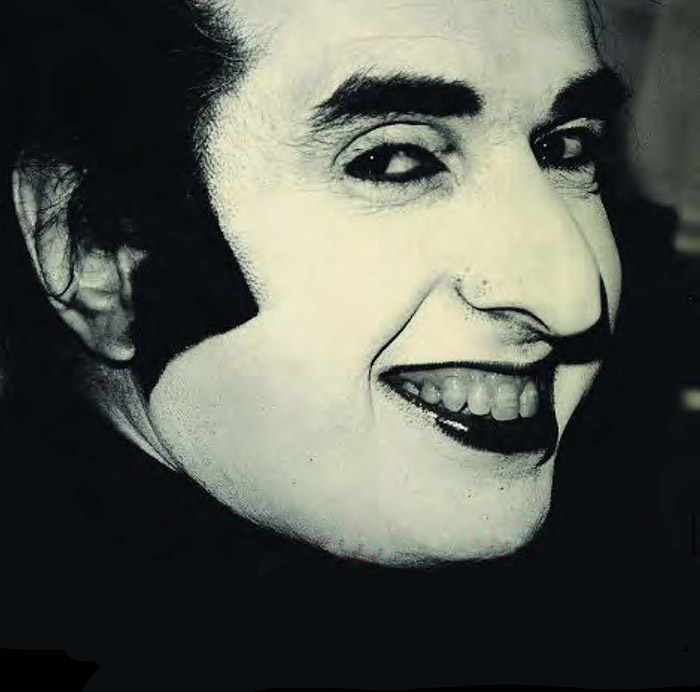REALITY present “STREET OF DREAMS”
A FILM BY MARTIN SHARP STARRING TINY TIM
Doors 7:30pm
Tickets £10 on door / Concs. £7
Advance £8 (Click Here)
REALITY proudly celebrate the art of psychedelic pioneer and co-founder of OZ magazine, Martin Sharp with a rare British screening of his unfinished film masterpiece “Street of Dreams”, accompanying an exhibition of psychic drawings by Ethel Le Rossignol, and starring the Leonardo Da Vinci of song, the late great Tiny Tim as he creates show business history with his sensational attempt at the World Professional Non-Stop Singing Record at Luna Park, Sydney, Australia. A Century of Song in one Smash Hit Marathon Medley of Melody ! PLUS Martin Sharp’s twelve minute film of Tiny Tim performing his apocalyptic rendition of Barry McGuire’s “Eve of Destruction”and other surprises. Don’t You Dare Miss It !!! _____________________________
Martin Sharp gave the 1960s counterculture its visual expression. Pop artist extraordinaire, innovator of psychedelic art he was one of the founders of the Australina underground magazine Oz together with Richard Neville. Born in Sydney Sharp’s satire was as keen-edged as his name and it was largely his cartoons, with their witty social and political observations, that made Oz successful. In 1966 Neville and Sharp headed for London via India. Martin was the first to arrive. Visiting the Speakeasy Club, he met Eric Clapton, who casually mentioned he was looking for lyrics. Sharp scrawled out the lines of Tales of Brave Ulysses, a poem he had just written. Clapton recorded the song for Cream's second album, Disraeli Gears (1967), and commissioned Martin to do the cover. Martin's gatefold sleeve for Cream's third album, Wheels of Fire, won the New York art directors' prize for best album design in 1969.
In 1967, Neville and Sharp, later co-editing with Jim Anderson and Felix Dennis, started London Oz which ran until prosecuted for supposed obscenity in a 1971 government crack down on hippies, dope and a general belated disapproval of the whole culture. With access to new print stocks, including metallic foils, new fluorescent inks and the freedom of layout offered by the offset printing system, Sharp's artistic skills came to the fore and Oz quickly won renown as one of the most visually exciting publications of its time.
Sharp lived in a studio at the top of the Pheasantry, an ornate building on the Kings Road, Chelsea, which he shared with a basement night club, Eric Clapton, Germaine Greer, (then writing The Female Eunuch), filmmaker Philippe Mora, artist Tim Whidborne, David Litvinoff (later an adviser on the production of Nicolas Roeg's “Performance”), writer Anthony Haden-Guest (author of The Last Party: Studio 54, Disco,and the Culture of the Night) and Sharp's friend Robert Whitaker, photographer of choice for many leading rock groups, including The Beatles. (Whitaker was responsible for the controversial "butcher" photo used on the original cover of the Beatles' album (“"Yesterday and Today.”) ; For his 1969 exhibition “Sharp Martin and His Silver Scissors”, he cut up, spliced and re-created works of art by his heroes Van Gogh, Hokusai and René Magritte. “Art Book”, a collection of his collages, was published in 1972
Sharp's involvement in OZ gradually decreased during 1968-69 and he returned to Australia where, over the next couple of years, he created the Yellow House (an artists' community open 24 hours a day), where each room was an artwork in itself. It received thousands of visitors before closing in 1973. By1972 he had taken on the renovation of Luna Park, the amusement park at Milsons Point, on the other side of Sydney harbour from the high art of the Opera House. He repainted the huge face at the entrance, the gateway into the fairground that he saw as a metaphor for the world.
While in London in 1968, Sharp had attended a concert at the Albert Hall by Tiny Tim, in whose renditions of popular songs Martin saw an echo of his own reconfiguring of old masters. Tim was a crooner in the mould of Valentino who emerged from the New York avant-garde to win the hearts of middle America. Looking like a scarecrow, deeply religious, girls still fell at his feet. Tiny played the ukulele left handed, though retained the standard string placement on instruments including a vintage Martin, a Favilla and rare Johnston metal resonator.
“Eric had seen Tiny Tim perform at The Scene in New York City and knowing I loved the old songs he urged me to go and see Tiny in his first London performance at the Royal Albert Hall. I'd never heard Tiny before and I was completely amazed by his extraordinary, joyful persona and his absolute mastery over the whole language of popular song. I felt I would love to work with him, but thought he was destined to the heights of stardom. I never felt the opportunity would arise. Over twenty years later I write this on letterhead from the film, "Street of Dreams" I have been making with Tiny over the last 12 years, thinking of the hundreds of songs and conversations I have recorded with him over the years. Thus was my entry into the world of popular song”.
"The meeting of musician and artist directly without intermediaries is, and always has and will be, a fruitful one. Such was the goodwill that existed in London during the late '60's that a painter from Australia could meet a great musician from England and informally give him some lyrics which would become a song, a friendship, a career with Tiny Tim, and a record cover."
“Tim's appropriation of song is very much like my appropriation of images. We are both collagists taking the elements of different epochs and mixing them to discover new relationships."
Sharp's appreciation of Tiny Tim manifested itself in many ways, including record production, costume design. He created a five-metre painting now hanging in Macquarie University, painted during the mid-1970s with Tim Lewis. His Tiny Tim Opera House concert poster is one of his most memorable and collectible images. His cherished Tiny Tim film project Street of Dreams is commemorated in the painting Film Script. He laboured for over a decade on this film and it almost forced him to sell his house to finance it. However, the story goes that on the eve of the sale, Sharp received a surprise cheque in the mail—a royalty payment for his lyrics for "Tales Of Brave Ulysses", which enabled him to continue working on the film without selling his house.
Martin Sharp spent over a decade making Street of Dreams, a film tribute to Tiny Tim and to Luna Park. A fire in the ghost train at Luna Park, which killed seven people, mostly children, in 1979, devastated Martin. He concluded that it was not accidental, and remained convinced that the culprits should have been brought to justice.
Tiny Tim's finest TV hour - his December 1969 marriage to a gawky 17-year old girl from New Jersey called Vicki Budinger (whom he rechristened Miss Vicki) - remains one of the highest-rated shows in US broadcasting history, beaten only by the Apollo 11 moon landing and the final episode of MASH. He had first spotted his bride in the crowd during a public appearance at a Philadelphia department store. After a six-month romance, they were married live on Johnny Carson's The Tonight Show. The studio was decked out with 10,000 tulips and 45 million people tuned in to watch.
Just before his death, on stage in Minneapolis in November 1996, Tiny Tim’s career had started to pick up again. But the untold tale of his bumpy ride at the lower echelons of the entertainment industry is as riveting as his rise. Martin Sharp’s unfinished “Street of Dreams” shows Tiny at a point in his life when, no longer able to get bookings at venues like the Sydney Opera House, he agrees to set a new world non-stop singing record at Luna Park , just across the bay. Sharp died in December 2013, aged 71.
When asked about his ambitions in 1970 by Playboy Magazine Tiny Tim answered:
“My greatest unfulfilled ambition, is to be one of the astronauts or even the first singer on the Moon. But most of all, I'd love to see Christ come back to crush the spirit of hate and make men put down their guns. I'd also like just one more hit single.”
Marsha Rowe, Chris Campion, Marek Pytel
http://www.realityfilm.co.uk

